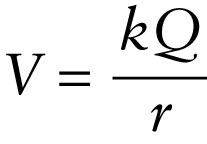Electric potential due to a point charge (17-8)
Question 1 of 4
Question
Electric potential due to a point charge Q
{"title":"Electric potential due to a point charge Q","description":"Correct!","type":"correct","color":"#99CCFF","code":"[{\"shape\":\"poly\",\"coords\":\"82,133\"},{\"shape\":\"rect\",\"coords\":\"10,16,12,16\"},{\"shape\":\"poly\",\"coords\":\"144,22\"},{\"shape\":\"rect\",\"coords\":\"5,52,46,96\"}]"} {"title":"Coulomb constant","description":"Wrong","type":"incorrect","color":"#ffcc00","code":"[{\"shape\":\"rect\",\"coords\":\"118,4,153,55\"}]"} {"title":"Value of the point charge","description":"Incorrect","type":"incorrect","color":"#333300","code":"[{\"shape\":\"rect\",\"coords\":\"227,24,228,24\"},{\"shape\":\"rect\",\"coords\":\"156,6,200,66\"}]"} {"title":"Distance from the point charge Q to the location where the potential is measured","description":"Incorrect","type":"incorrect","color":"#000080","code":"[{\"shape\":\"rect\",\"coords\":\"143,99,176,136\"}]"}Review
Equation 17-8 says that all points that are the same distance r from a point charge have the same electric potential due to that charge. It also says that if Q>0, the electric potential due to the charge is positive and decreases (becomes less positive) as you move farther away from the charge so that r increases. If Q<0, the electric potential due to the charge is negative and decreases (becomes more negative) as you move closer to the charge. For either sign of Q, the electric potential goes to zero at an infinite distance from the point charge.

